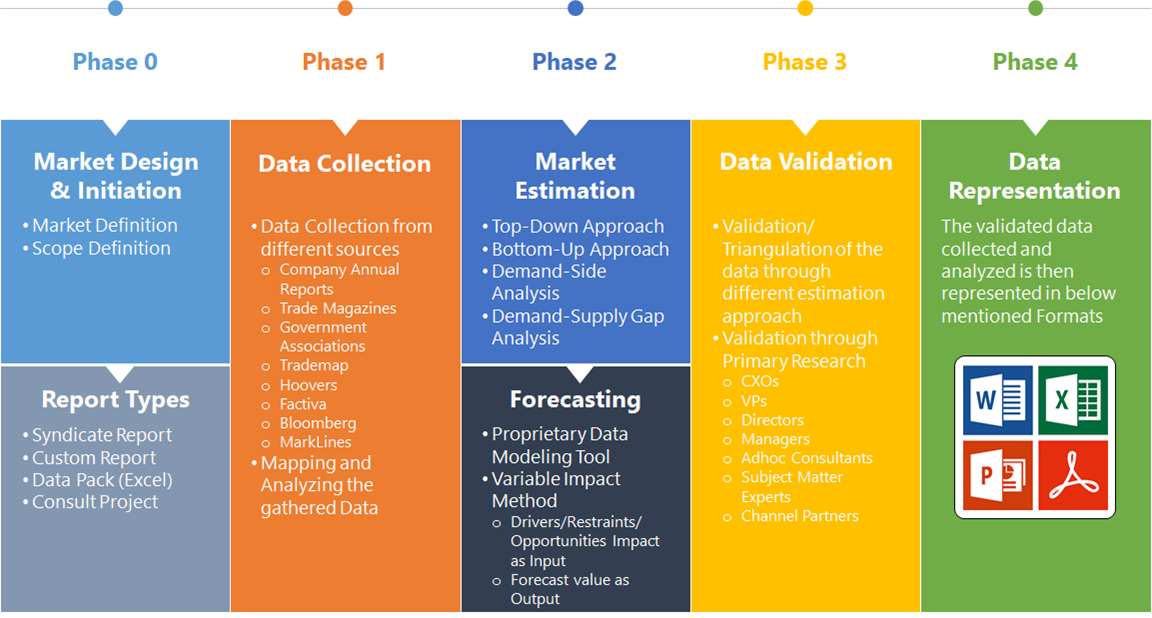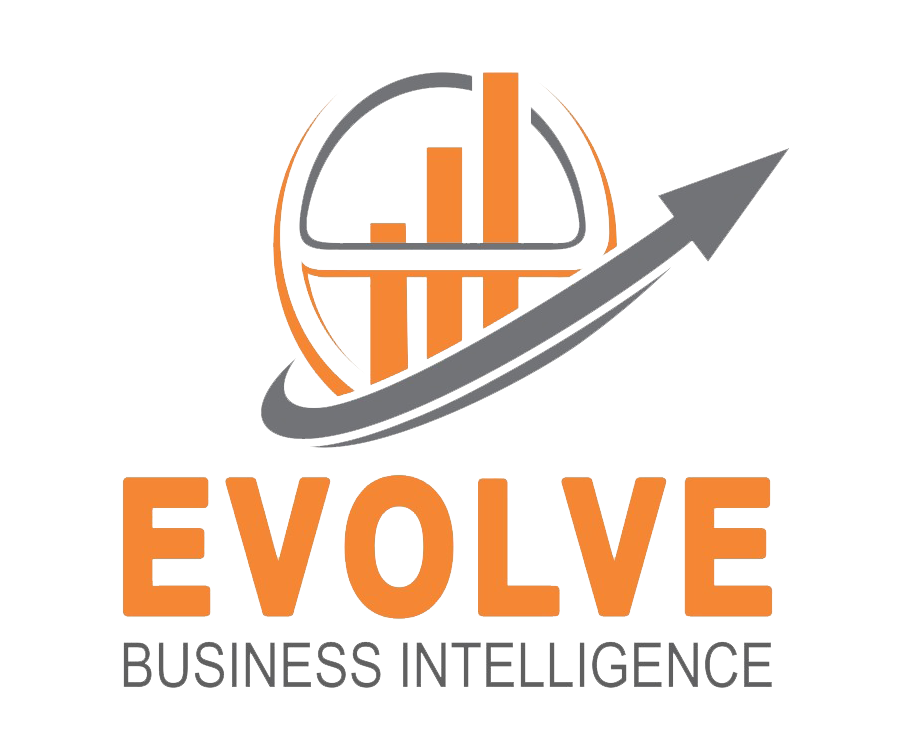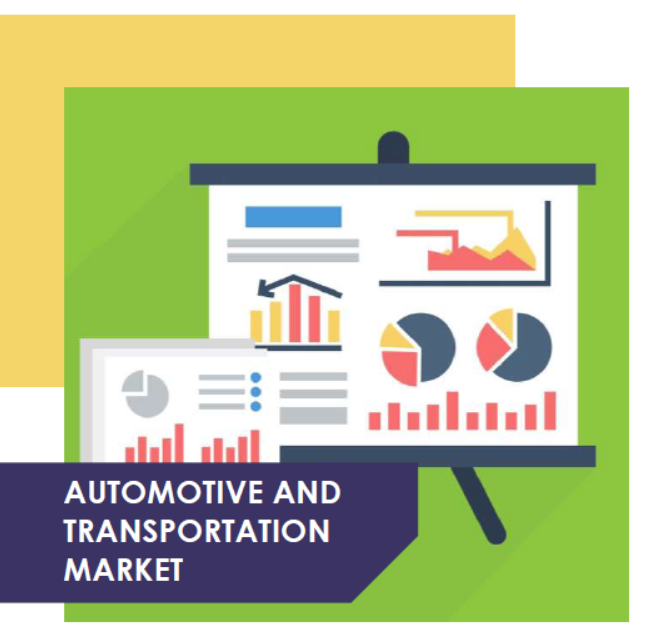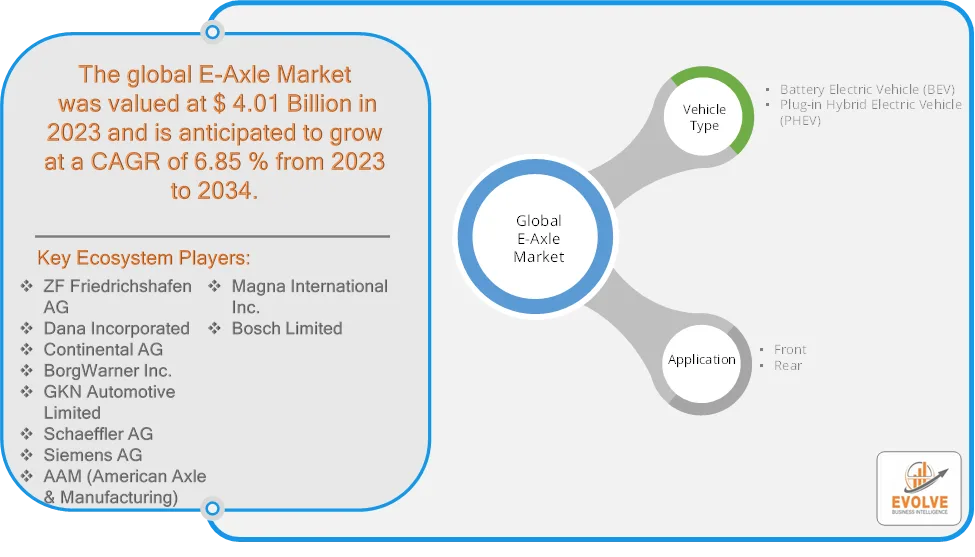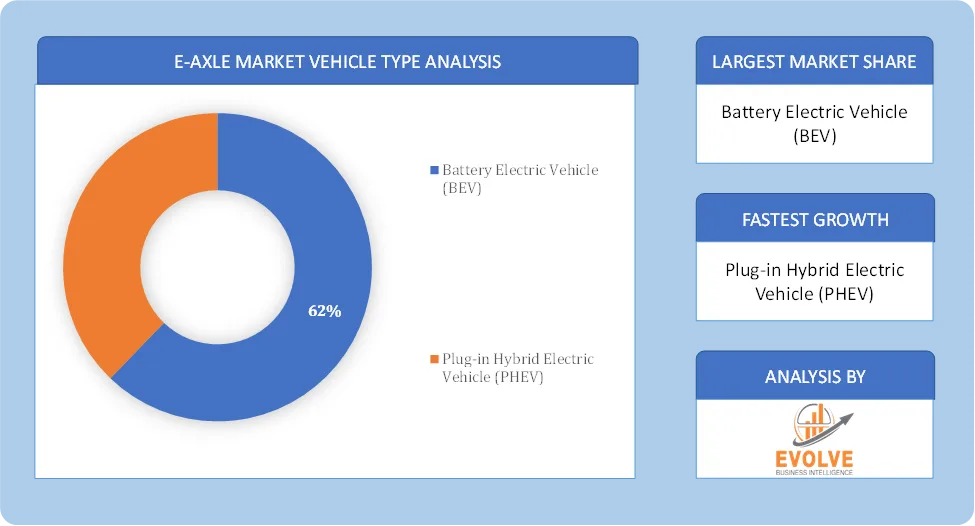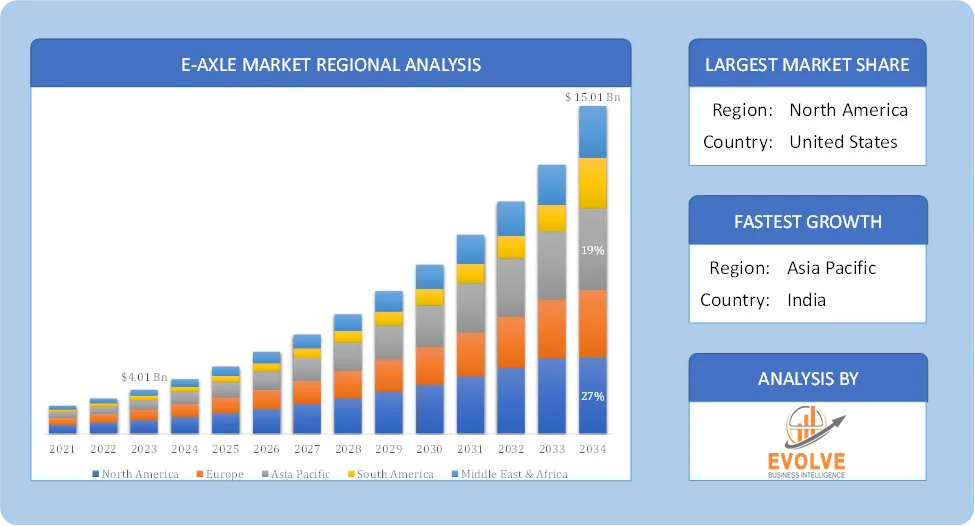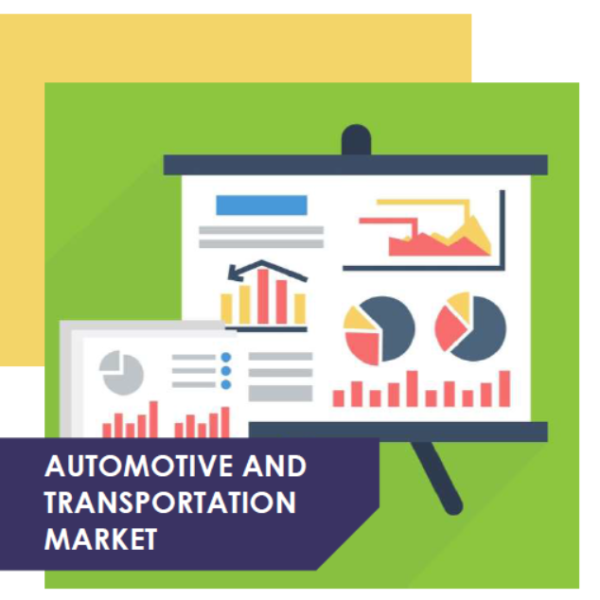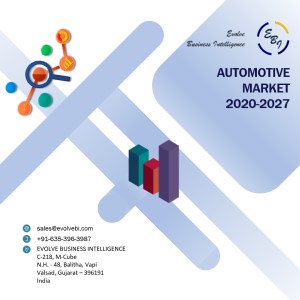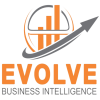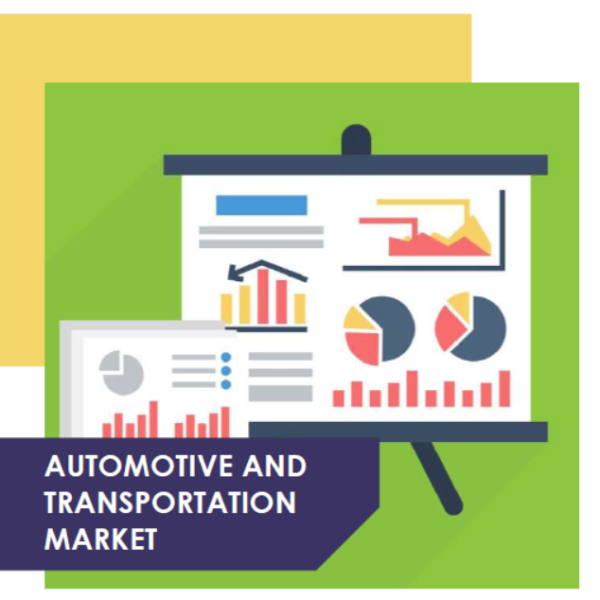E-Axle Market Analysis and Global Forecast 2023-2033
$ 1,390.00 – $ 5,520.00Price range: $ 1,390.00 through $ 5,520.00
E-Axle Market Research Report: Information By Application (Front, Rear), By Electric Vehicle Type (Battery Electric Vehicle (BEV), Plug-in Hybrid Electric Vehicle (PHEV)), and by Region — Forecast till 2033
Page: 165
E-Axle Market Overview
The E-Axle Market size accounted for USD 4.01 Billion in 2023 and is estimated to account for 8.21 Billion in 2024. The Market is expected to reach USD 15.01 Billion by 2034 growing at a compound annual growth rate (CAGR) of 6.85% from 2024 to 2034. The E-Axle Market is experiencing rapid growth due to the increasing adoption of electric vehicles (EVs) and the demand for integrated and efficient powertrain solutions. An E-Axle is a fully integrated system that combines electric motors, power electronics, and transmission into a single unit, optimizing vehicle efficiency and reducing overall weight.
The e-axle market is a dynamic and rapidly expanding sector within the automotive industry, driven by the global transition to electric mobility. Continuous technological advancements, supportive government policies, and decreasing costs are expected to fuel significant growth in the coming decade.
Global E-Axle Market Synopsis
 E-Axle Market Dynamics
E-Axle Market Dynamics
The major factors that have impacted the growth of E-Axle Market are as follows:
Drivers:
Ø Demand for Lightweight & Compact Powertrain Solutions
E-Axles combine motor, power electronics, and transmission in a single unit, reducing vehicle weight. A lighter powertrain improves vehicle efficiency, enhances battery range, and contributes to better overall performance. Integration of components in an E-Axle lowers the cost of assembly and manufacturing. The declining cost of electric motors and power electronics makes E-Axle solutions more affordable for mass-market EVs. The adoption of silicon carbide (SiC) power semiconductors enhances efficiency and reduces energy losses and innovations in permanent magnet motors and induction motors improve power density and performance.
Restraint:
- High Initial Development and Manufacturing Costs
E-Axle systems integrate multiple components (motor, power electronics, and transmission), making initial R&D and production expensive. Automakers and suppliers require high capital investments for setting up EV powertrain production and advanced testing facilities. E-Axle efficiency depends on battery performance, and battery limitations (range, charging time, degradation) can impact overall adoption. The high cost of EV batteries increases the overall cost of E-Axle-powered EVs, making them less attractive to cost-sensitive consumers and the integration of motor, inverter, and gearbox in an E-Axle generates high heat, requiring advanced thermal management systems.
Opportunity:
⮚ Advancements in Power Electronics & Motor Technology
Adoption of silicon carbide (SiC) and gallium nitride (GaN) power semiconductors can improve E-Axle efficiency. Development of lightweight materials for motors and gearboxes can enhance performance and extend battery range. Automakers are shifting toward dual-motor and AWD E-Axles for better performance and traction in EVs and Growing demand for sports EVs and off-road electric SUVs further boosts the AWD E-Axle market and E-Axles integrated with smart control systems, predictive maintenance, and AI-based efficiency optimization are gaining traction.
E-Axle Market Segment Overview
Based on Application, the market is segmented based on Front and Rear. The Rear segment dominant the market. In the automotive E-axle market, the rear segment refers to the integration of electric axle systems specifically designed for the rear wheels of a vehicle. This configuration is commonly employed to enhance traction, performance, and overall driving dynamics. A growing trend in this segment involves the adoption of rear E-axles in electric sports cars and high-performance vehicles.
By Vehicle Type
Based on Vehicle Type, the market segment has been divided into the Battery Electric Vehicle (BEV), Plug-in Hybrid Electric Vehicle (PHEV). The Battery Electric Vehicle (BEV) segment dominant the market. The Battery Electric Vehicle (BEV) segment specifically refers to electric vehicles powered solely by electric batteries without an internal combustion engine. In this segment, E-axles play a crucial role by integrating electric motors, power electronics, and gears into a compact unit, enhancing the performance and efficiency of BEVs.
Global E-Axle Market Regional Analysis
Based on region, the global E-Axle Market has been divided into North America, Europe, Asia-Pacific, the Middle East & Africa, and Latin America. North America is projected to dominate the use of the E-Axle Market followed by the Asia-Pacific and Europe regions.
 North America E-Axle Market
North America E-Axle Market
North America holds a dominant position in the E-Axle Market. the U.S. and Canada are witnessing strong EV adoption, driven by stringent emission regulations and government incentives. Growth in the electric commercial vehicle (eTruck, eBus) segment is fueling demand for high-performance E-Axles. Government incentives and policies supporting EV adoption and shifting consumer preference from high horsepower vehicles and large SUVs to compact electric cars in the U.S. Increasing awareness and concerns about climate change driving consumer preference towards EVs.
Asia-Pacific E-Axle Market
The Asia-Pacific region has indeed emerged as the fastest-growing market for the E-Axle Market industry. China dominates the global E-Axle market, driven by government policies supporting EV production. India, Japan, and South Korea are emerging markets for E-Axle adoption due to automotive electrification initiatives. Government incentives and supportive policies promoting EV adoption and domestic manufacturing capabilities, such as India’s ‘Electric Mobility Promotion Scheme’ and increasing urbanization and population growth driving the demand for sustainable transportation. Availability of low-cost labor and raw materials, contributing to increased vehicle production.
Competitive Landscape
The global E-Axle Market is highly competitive, with numerous players offering a wide range of software solutions. The competitive landscape is characterized by the presence of established companies, as well as emerging startups and niche players. To increase their market position and attract a wide consumer base, the businesses are employing various strategies, such as product launches, and strategic alliances.
Prominent Players:
- ZF Friedrichshafen AG
- Dana Incorporated
- Continental AG
- BorgWarner Inc.
- GKN Automotive Limited
- Schaeffler AG
- Siemens AG
- AAM (American Axle & Manufacturing)
- Magna International Inc.
- Bosch Limited.
Scope of the Report
Global E-Axle Market, by Application
- Front
- Rear
Global E-Axle Market, by Electric Vehicle Type
- Battery Electric Vehicle (BEV)
- Plug-in Hybrid Electric Vehicle (PHEV)
Global E-Axle Market, by Region
- North America
- US
- Canada
- Mexico
- Europe
- UK
- Germany
- France
- Italy
- Spain
- Benelux
- Nordic
- Rest of Europe
- Asia Pacific
- China
- Japan
- South Korea
- Indonesia
- Austalia
- Malaysia
- India
- Rest of Asia Pacific
- South America
- Brazil
- Argentina
- Rest of SouthAmerica
- Middle East &Africa
- Saudi Arabia
- UAE
- Egypt
- SouthAfrica
- Rest of Middle East & Africa
| Parameters | Indicators |
|---|---|
| Market Size | 2033: USD 15.01 Billion |
| CAGR (2023-2033) | 6.85% |
| Base year | 2022 |
| Forecast Period | 2023-2033 |
| Historical Data | 2021 (2017 to 2020 On Demand) |
| Report Coverage | Revenue Forecast, Competitive Landscape, Growth Factors, and Trends |
| Key Segmentations | Application, Electric Vehicle Type |
| Geographies Covered | North America, Europe, Asia-Pacific, South America, Middle East, Africa |
| Key Vendors | ZF Friedrichshafen AG, Dana Incorporated, Continental AG, BorgWarner Inc., GKN Automotive Limited, Schaeffler AG, Siemens AG, AAM (American Axle & Manufacturing), Magna International Inc. and Bosch Limited. |
| Key Market Opportunities | · Advancements in Power Electronics & Motor Technology |
| Key Market Drivers | · Demand for Lightweight & Compact Powertrain Solutions |
REPORT CONTENT BRIEF:
- High-level analysis of the current and future E-Axle Market trends and opportunities
- Detailed analysis of current market drivers, restraining factors, and opportunities in the future
- E-Axle Market historical market size for the year 2021, and forecast from 2023 to 2033
- E-Axle Market share analysis at each product level
- Competitor analysis with detailed insight into its product segment, Government & Defense strength, and strategies adopted.
- Identifies key strategies adopted including product launches and developments, mergers and acquisitions, joint ventures, collaborations, and partnerships as well as funding taken and investment done, among others.
- To identify and understand the various factors involved in the global E-Axle Market affected by the pandemic
- To provide a detailed insight into the major companies operating in the market. The profiling will include the Government & Defense health of the company’s past 2-3 years with segmental and regional revenue breakup, product offering, recent developments, SWOT analysis, and key strategies.
Frequently Asked Questions (FAQ)
What is the study period of this market?
The study period of the global E-Axle Market is 2021- 2033
What is the growth rate of the global E-Axle Market?
The global E-Axle Market is growing at a CAGR of 5.78% over the next 10 years
Which region has the highest growth rate in the market of E-Axle Market?
Asia Pacific is expected to register the highest CAGR during 2023-2033
Which region has the largest share of the global E-Axle Market?
North America holds the largest share in 2022
Who are the key players in the global E-Axle Market?
ZF Friedrichshafen AG, Dana Incorporated, Continental AG, BorgWarner Inc., GKN Automotive Limited, Schaeffler AG, Siemens AG, AAM (American Axle & Manufacturing), Magna International Inc. and Bosch Limited. are the major companies operating in the market.
Do you offer Post Sale Support?
Yes, we offer 16 hours of analyst support to solve the queries
Do you sell particular sections of a report?
Yes, we provide regional as well as country-level reports. Other than this we also provide a sectional report. Please get in contact with our sales representatives.
Press Release

Global Pharmaceutical Manufacturing Market to Reach $1.38 Trillion by 2035 with 7.35% CAGR, New Research Shows

The Global Mammography Market Is Estimated To Record a CAGR of Around 10.29% During The Forecast Period

Glue Stick Market to Reach USD 2.35 Billion by 2034

Podiatry Service Market to Reach USD 11.88 Billion by 2034

Microfluidics Technology Market to Reach USD 32.58 Billion by 2034

Ferric Chloride Market to Reach USD 10.65 Billion by 2034

Family Practice EMR Software Market to Reach USD 21.52 Billion by 2034

Electric Hairbrush Market to Reach USD 15.95 Billion by 2034

Daily Bamboo Products Market to Reach USD 143.52 Billion by 2034

Cross-border E-commerce Logistics Market to Reach USD 112.65 Billion by 2034
Table of Content
Chapter 1. Executive Summary
Chapter 2. Scope Of The Study
2.1. Market Definition
2.2. Scope Of The Study
2.2.1. Objectives of Report
2.2.2. Limitations
2.3. Market Structure
Chapter 3. Evolve BI Methodology
Chapter 4. Market Insights and Trends
4.1. Supply/ Value Chain Analysis
4.1.1. Raw End Users Providers
4.1.2. Manufacturing Process
4.1.3. Distributors/Retailers
4.1.4. End-Use Industry
4.2. Porter’s Five Forces Analysis
4.2.1. Threat Of New Entrants
4.2.2. Bargaining Power Of Buyers
4.2.3. Bargaining Power Of Suppliers
4.2.4. Threat Of Substitutes
4.2.5. Industry Rivalry
4.3. Impact Of COVID-19 on the E-Axle Market
4.3.1. Impact on Market Size
4.3.2. End-Use Industry Trend, Preferences, and Budget Impact
4.3.3. Regulatory Framework/Government Policies
4.3.4. Key Players' Strategy to Tackle Negative Impact
4.3.5. Opportunity Window
4.4. Technology Overview
12.28. Macro factor
4.6. Micro Factor
4.7. Demand Supply Gap Analysis of the E-Axle Market
4.8. Import Analysis of the E-Axle Market
4.9. Export Analysis of the E-Axle Market
Chapter 5. Market Dynamics
5.1. Introduction
5.2. DROC Analysis
5.2.1. Drivers
5.2.2. Restraints
5.2.3. Opportunities
5.2.4. Challenges
5.3. Patent Analysis
5.4. Industry Roadmap
5.5. Parent/Peer Market Analysis
Chapter 6. Global E-Axle Market, By Application
6.1. Introduction
6.2. Front
6.3. Rear
Chapter 7. Global E-Axle Market, By Electric Vehicle Type
7.1. Introduction
7.2. Battery Electric Vehicle (BEV)
7.3. Plug-in Hybrid Electric Vehicle (PHEV)
Chapter 8. Global E-Axle Market, By Region
8.1. Introduction
8.2. North America
8.2.1. Introduction
8.2.2. Driving Factors, Opportunity Analyzed, and Key Trends
8.2.3. Market Size and Forecast, By Country, 2024-2034
8.2.4. Market Size and Forecast, By Product Type, 2024-2034
8.2.5. Market Size and Forecast, By End User, 2024-2034
8.2.6. US
8.2.6.1. Introduction
8.2.6.2. Driving Factors, Opportunity Analyzed, and Key Trends
8.2.6.3. Market Size and Forecast, By Product Type, 2024-2034
8.2.6.4. Market Size and Forecast, By End User, 2024-2034
8.2.7. Canada
8.2.7.1. Introduction
8.2.7.2. Driving Factors, Opportunity Analyzed, and Key Trends
8.2.7.4. Market Size and Forecast, By Product Type, 2024-2034
8.2.7.5. Market Size and Forecast, By End User, 2024-2034
8.3. Europe
8.3.1. Introduction
8.3.2. Driving Factors, Opportunity Analyzed, and Key Trends
8.3.3. Market Size and Forecast, By Country, 2024-2034
8.3.4. Market Size and Forecast, By Product Type, 2024-2034
8.3.5. Market Size and Forecast, By End User, 2024-2034
8.3.6. Germany
8.3.6.1. Introduction
8.3.6.2. Driving Factors, Opportunity Analyzed, and Key Trends
8.3.6.3. Market Size and Forecast, By Product Type, 2024-2034
8.3.6.4. Market Size and Forecast, By End User, 2024-2034
8.3.7. France
8.3.7.1. Introduction
8.3.7.2. Driving Factors, Opportunity Analyzed, and Key Trends
8.3.7.3. Market Size and Forecast, By Product Type, 2024-2034
8.3.7.4. Market Size and Forecast, By End User, 2024-2034
8.3.8. UK
8.3.8.1. Introduction
8.3.8.2. Driving Factors, Opportunity Analyzed, and Key Trends
8.3.8.3. Market Size and Forecast, By Product Type, 2024-2034
8.3.8.4. Market Size and Forecast, By End User, 2024-2034
8.3.9. Italy
8.3.9.1. Introduction
8.3.9.2. Driving Factors, Opportunity Analyzed, and Key Trends
8.3.9.3. Market Size and Forecast, By Product Type, 2024-2034
8.3.9.4. Market Size and Forecast, By End User, 2024-2034
8.3.11. Rest Of Europe
8.3.11.1. Introduction
8.3.11.2. Driving Factors, Opportunity Analyzed, and Key Trends
8.3.11.3. Market Size and Forecast, By Product Type, 2024-2034
8.3.11.4. Market Size and Forecast, By End User, 2024-2034
8.4. Asia-Pacific
8.4.1. Introduction
8.4.2. Driving Factors, Opportunity Analyzed, and Key Trends
8.4.3. Market Size and Forecast, By Country, 2024-2034
8.4.4. Market Size and Forecast, By Product Type, 2024-2034
8.12.28. Market Size and Forecast, By End User, 2024-2034
8.4.6. China
8.4.6.1. Introduction
8.4.6.2. Driving Factors, Opportunity Analyzed, and Key Trends
8.4.6.3. Market Size and Forecast, By Product Type, 2024-2034
8.4.6.4. Market Size and Forecast, By End User, 2024-2034
8.4.7. India
8.4.7.1. Introduction
8.4.7.2. Driving Factors, Opportunity Analyzed, and Key Trends
8.4.7.3. Market Size and Forecast, By Product Type, 2024-2034
8.4.7.4. Market Size and Forecast, By End User, 2024-2034
8.4.8. Japan
8.4.8.1. Introduction
8.4.8.2. Driving Factors, Opportunity Analyzed, and Key Trends
8.4.8.3. Market Size and Forecast, By Product Type, 2024-2034
8.4.8.4. Market Size and Forecast, By End User, 2024-2034
8.4.9. South Korea
8.4.9.1. Introduction
8.4.9.2. Driving Factors, Opportunity Analyzed, and Key Trends
8.4.9.3. Market Size and Forecast, By Product Type, 2024-2034
8.4.9.4. Market Size and Forecast, By End User, 2024-2034
8.4.10. Rest Of Asia-Pacific
8.4.10.1. Introduction
8.4.10.2. Driving Factors, Opportunity Analyzed, and Key Trends
8.4.10.3. Market Size and Forecast, By Product Type, 2024-2034
8.4.10.4. Market Size and Forecast, By End User, 2024-2034
8.5. Rest Of The World (RoW)
8.5.1. Introduction
8.5.2. Driving Factors, Opportunity Analyzed, and Key Trends
8.5.3. Market Size and Forecast, By Product Type, 2024-2034
8.5.4. Market Size and Forecast, By End User, 2024-2034
Chapter 9. Company Landscape
9.1. Introduction
9.2. Vendor Share Analysis
9.3. Key Development Analysis
9.4. Competitor Dashboard
Chapter 10. Company Profiles
10.1. ZF Friedrichshafen AG
10.1.1. Business Overview
10.1.2. Government & Defense Analysis
10.1.2.1. Government & Defense – Existing/Funding
10.1.3. Product Portfolio
10.1.4. Recent Development and Strategies Adopted
10.1.5. SWOT Analysis
10.2. Dana Incorporated
10.2.1. Business Overview
10.2.2. Government & Defense Analysis
10.2.2.1. Government & Defense – Existing/Funding
10.2.3. Product Portfolio
10.2.4. Recent Development and Strategies Adopted
10.2.5. SWOT Analysis
10.3. Continental AG
10.3.1. Business Overview
10.3.2. Government & Defense Analysis
10.3.2.1. Government & Defense – Existing/Funding
10.3.3. Product Portfolio
10.3.4. Recent Development and Strategies Adopted
10.3.5. SWOT Analysis
10.4. BorgWarner Inc.
10.4.1. Business Overview
10.4.2. Government & Defense Analysis
10.4.2.1. Government & Defense – Existing/Funding
10.4.3. Product Portfolio
10.4.4. Recent Development and Strategies Adopted
10.12.28. SWOT Analysis
10.5. GKN Automotive Limited
10.5.1. Business Overview
10.5.2. Government & Defense Analysis
10.5.2.1. Government & Defense – Existing/Funding
10.5.3. Product Portfolio
10.5.4. Recent Development and Strategies Adopted
10.5.5. SWOT Analysis
10.6. Schaeffler AG
10.6.1. Business Overview
10.6.2. Government & Defense Analysis
10.6.2.1. Government & Defense – Existing/Funding
10.6.3. Product Portfolio
10.6.4. Recent Development and Strategies Adopted
10.6.5. SWOT Analysis
10.7. Siemens AG
10.7.1. Business Overview
10.7.2. Government & Defense Analysis
10.7.2.1. Government & Defense – Existing/Funding
10.7.3. Product Portfolio
10.7.4. Recent Development and Strategies Adopted
10.7.5. SWOT Analysis
10.8 AAM (American Axle & Manufacturing)
10.8.1. Business Overview
10.8.2. Government & Defense Analysis
10.8.2.1. Government & Defense – Existing/Funding
10.8.3. Product Portfolio
10.8.4. Recent Development and Strategies Adopted
10.8.5. SWOT Analysis
10.9 Magna International Inc.
10.9.1. Business Overview
10.9.2. Government & Defense Analysis
10.9.2.1. Government & Defense – Existing/Funding
10.9.3. Product Portfolio
10.9.4. Recent Development and Strategies Adopted
10.9.5. SWOT Analysis
10.10. Bosch Limited.
10.10.1. Business Overview
10.10.2. Government & Defense Analysis
10.9.2.1. Government & Defense – Existing/Funding
10.10.3. Product Portfolio
10.10.4. Recent Development and Strategies Adopted
10.10.5. SWOT Analysis
Connect to Analyst
Research Methodology
